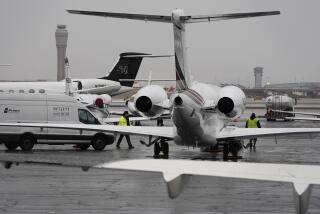Debate Delayed Aviation Trust Fund Use
- Share via
WASHINGTON — Federal officials acknowledged Tuesday that a long-term debate over use of the government’s aviation trust fund has allowed a $7.6-billion balance to build up while needed improvements, such as a new radar system at Los Angeles International Airport, have lagged behind schedule.
In the wake of Friday’s USAir crash at the airport, questions have been raised about the failure to modernize antiquated radar systems there and at other facilities with money from the fund, which is fed by excise taxes on airline tickets and administered by the Federal Aviation Administration.
Although the cause of Friday’s crash remains under investigation, officials have noted that two radar systems used by air traffic controllers were not operating properly. A $3-million project to replace one of the systems has been delayed for several years, officials said.
The federal aviation trust fund was established 21 years ago to finance airport capital improvements. But transportation officials said that it has been allowed to accumulate a big balance because of the federal budget deficit and disagreements over how the money should be spent.
Past administrations, Republican and Democratic alike, saw the trust fund as a hedge against rising federal deficits and were reluctant to use it entirely for air safety equipment and improvements. So the fund repeatedly has been used to cover many FAA operating expenses that otherwise would have been financed from the general treasury.
In the late 1980s, in fact, the trust fund was used to pay more than half the salaries and other costs of running the FAA.
That long-running debate--between proponents of using the fund only for capital improvements and those who favor using it to help support operations--now seems to be resolved. But it still will be some time before the $7.6-billion balance will be worked down.
Last fall, Congress and the Bush Administration agreed to a new approach as part of a five-year deficit-reduction package. Under the agreement, a bigger portion of the fund will be used to finance the FAA’s day-to-day operations but more spending on new equipment and facilities for air safety also will be authorized.
Beginning this year, the trust fund will cover the cost of about 75% of all FAA operations--up from 55% in recent years, agency officials said. Meanwhile, capital expenditures for air safety will be accelerated. The trust fund’s balance will be reduced to $1 billion over the next four years, congressional aides said.
Controversy over the fund’s use developed soon after it was created by Congress in 1970. According to a study by the Congressional Budget Office, Congress meant the fund to be used for airport and airway systems and “to the extent funds were available,” for operating costs as well.
However, the Nixon Administration proposed in 1971 that capital spending be restricted, and that FAA operations be fully funded from the trust, the study noted. Congress reacted by restricting the fund only to capital expenditures.
Six years later, the rules changed again to authorize some spending on operational costs. In practice, that represented about 15% of FAA outlays through 1980.
Later Congress continued trust fund financing of FAA operations, but restricted the amount. FAA officials said that from 1971 to 1988, the agency spent $25 billion to modernize the air safety system.
Still, the balance has built up rapidly from proceeds of the 8% federal excise tax on all domestic airline tickets, which generates about $4 billion annually. Since 1982, more than $32 billion has been raised for the fund.
In a related action last year, Congress raised the airline ticket tax to 10% from the previous 8%. The additional 2%, at least for now, is going into the trust fund. A congressional attorney, however, said it appears that Congress intended the 2% increase to go into the general fund and action may be taken to reroute the funds.
More to Read
Sign up for Essential California
The most important California stories and recommendations in your inbox every morning.
You may occasionally receive promotional content from the Los Angeles Times.












